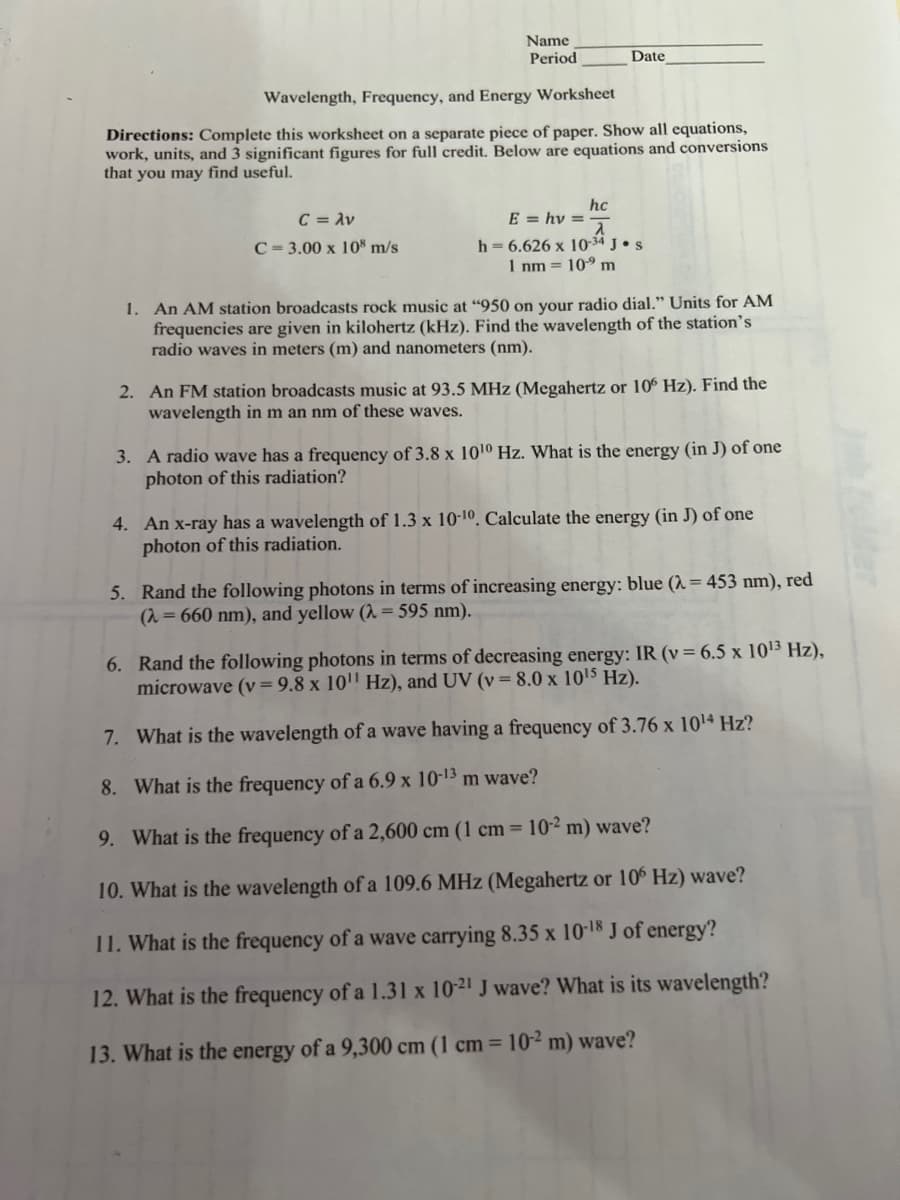1. An AM station broadcasts rock music at "950 on your radio dial." Units for AM frequencies are given in kilohertz (kHz). Find the wavelength of the station's radio waves in meters (m) and nanometers (nm).
1. An AM station broadcasts rock music at "950 on your radio dial." Units for AM frequencies are given in kilohertz (kHz). Find the wavelength of the station's radio waves in meters (m) and nanometers (nm).
Chemistry: The Molecular Science
5th Edition
ISBN:9781285199047
Author:John W. Moore, Conrad L. Stanitski
Publisher:John W. Moore, Conrad L. Stanitski
Chapter5: Electron Configurations And The Periodic Table
Section: Chapter Questions
Problem 5.ACP
Related questions
Question
Hello I was wondering if you could please create an answer key with no work since the paper is asking us for both however I’d just like the answer key to see as a reference that my answers will be correct thank you so much sorry for the bother :)

Transcribed Image Text:Name
Period
Date
Wavelength, Frequency, and Energy Worksheet
Directions: Complete this worksheet on a separate piece of paper. Show all equations,
work, units, and 3 significant figures for full credit. Below are equations and conversions
that you may find useful.
hc
C = λν
E = hv==
a
C=3.00 x 108 m/s
h = 6.626 x 10-34 J. S
1 nm = 10⁹ m
1. An AM station broadcasts rock music at "950 on your radio dial." Units for AM
frequencies are given in kilohertz (kHz). Find the wavelength of the station's
radio waves in meters (m) and nanometers (nm).
2. An FM station broadcasts music at 93.5 MHz (Megahertz or 106 Hz). Find the
wavelength in m an nm of these waves.
3. A radio wave has a frequency of 3.8 x 10¹0 Hz. What is the energy (in J) of one
photon of this radiation?
4. An x-ray has a wavelength of 1.3 x 10-10. Calculate the energy (in J) of one
photon of this radiation.
5. Rand the following photons in terms of increasing energy: blue (λ = 453 nm), red
(λ= 660 nm), and yellow (λ = 595 nm).
6. Rand the following photons in terms of decreasing energy: IR (v = 6.5 x 10¹³ Hz),
microwave (v = 9.8 x 10¹¹ Hz), and UV (v = 8.0 x 10¹5 Hz).
7. What is the wavelength of a wave having a frequency of 3.76 x 10¹4 Hz?
8. What is the frequency of a 6.9 x 10-13 m wave?
9. What is the frequency of a 2,600 cm (1 cm = 10-2 m) wave?
10. What is the wavelength of a 109.6 MHz (Megahertz or 106 Hz) wave?
11. What is the frequency of a wave carrying 8.35 x 10-18 J of energy?
12. What is the frequency of a 1.31 x 10-21 J wave? What is its wavelength?
13. What is the energy of a 9,300 cm (1 cm = 10-2 m) wave?
Expert Solution
This question has been solved!
Explore an expertly crafted, step-by-step solution for a thorough understanding of key concepts.
This is a popular solution!
Trending now
This is a popular solution!
Step by step
Solved in 2 steps with 1 images

Knowledge Booster
Learn more about
Need a deep-dive on the concept behind this application? Look no further. Learn more about this topic, chemistry and related others by exploring similar questions and additional content below.Recommended textbooks for you

Chemistry: The Molecular Science
Chemistry
ISBN:
9781285199047
Author:
John W. Moore, Conrad L. Stanitski
Publisher:
Cengage Learning

Chemistry & Chemical Reactivity
Chemistry
ISBN:
9781133949640
Author:
John C. Kotz, Paul M. Treichel, John Townsend, David Treichel
Publisher:
Cengage Learning

Chemistry & Chemical Reactivity
Chemistry
ISBN:
9781337399074
Author:
John C. Kotz, Paul M. Treichel, John Townsend, David Treichel
Publisher:
Cengage Learning

Chemistry: The Molecular Science
Chemistry
ISBN:
9781285199047
Author:
John W. Moore, Conrad L. Stanitski
Publisher:
Cengage Learning

Chemistry & Chemical Reactivity
Chemistry
ISBN:
9781133949640
Author:
John C. Kotz, Paul M. Treichel, John Townsend, David Treichel
Publisher:
Cengage Learning

Chemistry & Chemical Reactivity
Chemistry
ISBN:
9781337399074
Author:
John C. Kotz, Paul M. Treichel, John Townsend, David Treichel
Publisher:
Cengage Learning

Introduction to General, Organic and Biochemistry
Chemistry
ISBN:
9781285869759
Author:
Frederick A. Bettelheim, William H. Brown, Mary K. Campbell, Shawn O. Farrell, Omar Torres
Publisher:
Cengage Learning

Chemistry for Engineering Students
Chemistry
ISBN:
9781337398909
Author:
Lawrence S. Brown, Tom Holme
Publisher:
Cengage Learning